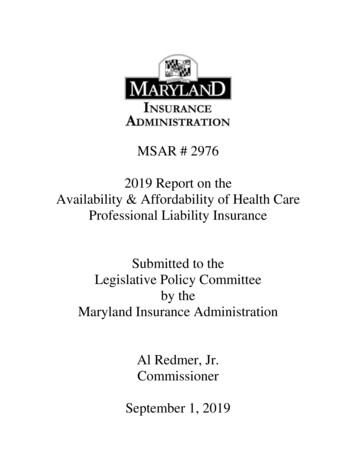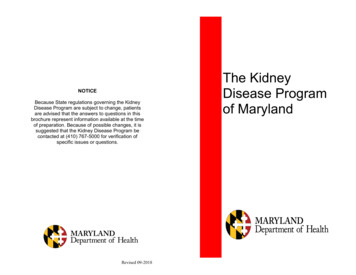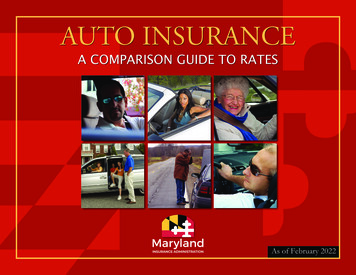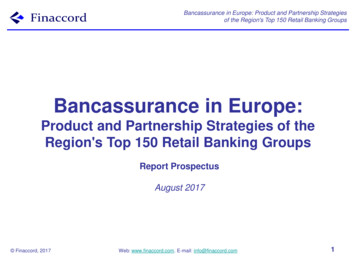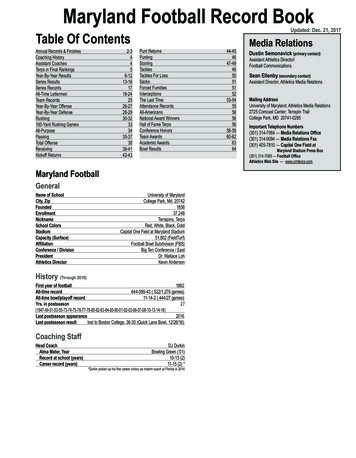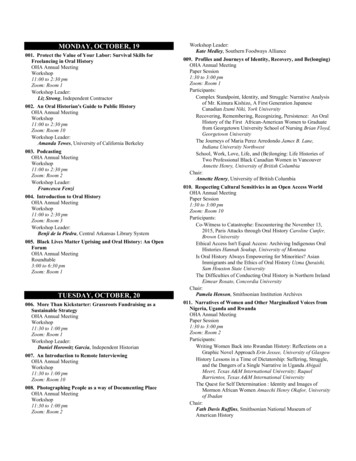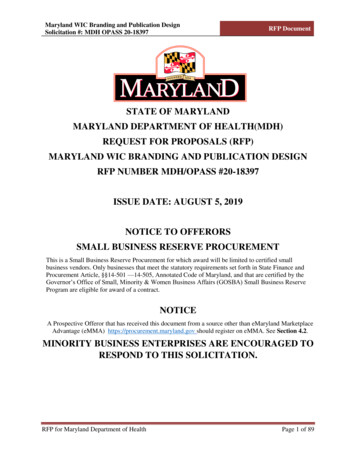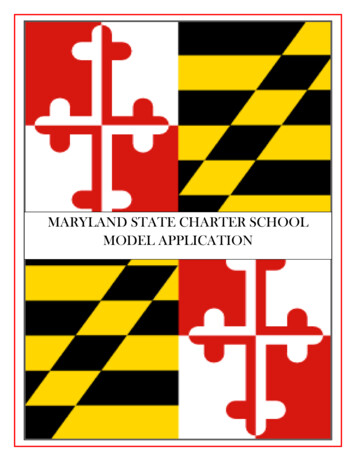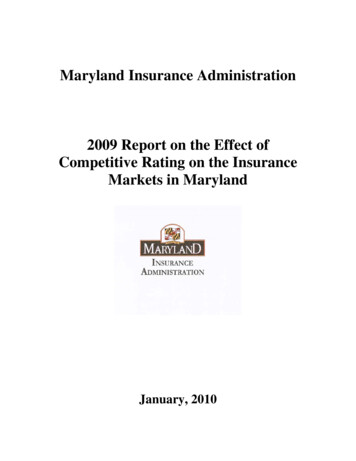
Transcription
Maryland Insurance Administration2009 Report on the Effect ofCompetitive Rating on the InsuranceMarkets in MarylandJanuary, 2010
Maryland Insurance Administration2009 Report on the Effect of Competitive Rating on the InsuranceMarkets in MarylandTable of ContentsI. Preface 1II. Competitive Rating 1III. Evaluating the Competitive Market 2IV. Private Passenger Automobile Insurance 2V. Homeowner's Insurance 5VI. Conclusions 7VII. Exhibits 8
I. PrefaceEach year, the Insurance Commissioner is required to report to the Governor and theGeneral Assembly on the effect of competitive rating on the insurance markets in the State. (See§11-338 of the Insurance Article.) This report summarizes Maryland’s competitive rating lawand provides information on the competitiveness of the market in two of the most importantinsurance markets for consumers, private passenger automobile insurance and homeownersinsurance for calendar year 2008.II. Competitive RatingThe Insurance Reform Act of 1995 (HB 923, Competitive Rating) authorized insurers touse rates for certain lines of property and casualty insurance without the prior approval of theCommissioner. Each authorized insurer and each rating organization designated by an insurerfor the filing of rates must file with the Commissioner all rates and supplementary rateinformation as well as any changes to rates or supplementary rate information on or before thedate they become effective. (See §11-307 of the Insurance Article.) In accordance withratemaking principles, rates may not be excessive, inadequate, or unfairly discriminatory. Undercompetitive rating, the Commissioner may only find a rate to be excessive if it is unreasonablyhigh for the insurance provided and the Commissioner has issued a ruling that a reasonabledegree of competition does not exist in the market to which the rate is applicable. (See §11-306of the Insurance Article.)States moved from prior approval of rates to competitive rating to allow insurers to reactquickly to business cycles. When claims experience is favorable, it is anticipated that insurers1
will generally act to decrease rates and/or relax underwriting restrictions to increase their marketshare. When claims experience deteriorates, it is anticipated that insurers will generally act toincrease rates and/or tighten their underwriting standards to accept less risk. Proponents ofcompetitive rating maintain that competition between insurers prevents excessive rating evenduring a downturn in the business cycle because no insurer is willing to raise rates to the pointwhere it will lose significant market share to one or more of its competitors. Moreover,competition encourages insurers to accept more risks, making insurance widely available toconsumers.III. Evaluating the Competitive MarketIn determining the competitiveness of a market, the Commissioner must consider allrelevant factors including: The number of insurers providing coverage in the market; The concentration of market share of those insurers; Changes in market share of the insurers; and Ease of entry for new insurers/products.(See §11-308 of the Insurance Article.)The subsequent sections of this report examine the number of insurers providingcoverage and the market share for these insurers in two insurance lines, private passengerautomobile insurance and homeowners insurance, for calendar year 2008.IV. Private Passenger Automobile InsuranceDuring calendar year 2008, there were 148 companies actively providing privatepassenger automobile insurance and related products in the State of Maryland. Many of these2
companies are owned by the same holding company (hereinafter “insurer group”). 1 Exhibit 1Aidentifies the top ten insurer groups, the individual companies comprising each insurer group andthe 2008 written premium for the insurer group as well as each individual company. Of the 148companies writing private passenger automobile insurance, 55 are a part of the top ten insurergroups.The market share for the top ten insurer groups has remained relatively stable between2003 and 2008. (See Exhibit 1.) In 2003, these top ten insurer groups accounted for about 85percent of the private passenger automobile insurance market increasing to just over 89 percentby 2008. 2 Over this six year period, the market share for GEICO, Allstate, Liberty Mutual andTravelers has increased and the market share for State Farm, Nationwide, Erie, Progressive, andUSAA has fluctuated somewhat, but have basically remained stable, while MarylandAutomobile Insurance Fund’s (MAIF) market share has decreased significantly.A commonly accepted measure of market concentration is the Herfindahl-HirschmanIndex (HHI). 3 Markets in which HHI is between 1000 and 1800 points are considered to bemoderately concentrated and those in which the HHI is in excess of 1800 points are consideredto be concentrated. Using the market share for each of the top ten insurers for Maryland 2008,the HHI for Maryland is 1183 up from 1044 for 2003, suggesting a minimally concentratedmarket. 41Insurer groups are being used in this report as opposed to individual companies as this provides a consistentcomparison of data over the years due to individual company mergers and acquisitions.2According to the National Association of Insurance Commissioners, the top ten insurer groups accounted for 66.6percent of the direct premiums written countrywide in 2008 for private passenger automobile insurance.3This is calculated by squaring the market share of each firm competing in the market and then summing theresulting numbers. The HHI takes into account the relative size and distribution of the firms in a market andapproaches zero when a market consists of a large number of firms of relatively equal size. The HHI increases bothas the number of firms in the market decreases and as the disparity in size between those firms increases.4Using market share for the top ten insurer groups for 2008 from the National Association of InsuranceCommissioners, the HHI for the nation as a whole is 642, an indication of a competitive national market.3
In the private passenger automobile insurance market, individuals with riskcharacteristics that private passenger auto insurers are unwilling to accept are able to obtaincoverage from MAIF. In 2003, MAIF had 6.39 percent of the private passenger auto insurancemarket. This decreased by about 55 percent in 2008 to 2.85 percent. Over this six year period,private passenger auto insurers appear to have competed for greater market share by acceptingmore risk, a sign of a competitive market.In a competitive market, rates are responsive to changing conditions. Table 1 belowshows the average premium expenditure – representing the average premium paid per vehicle -for automobile liability and physical damage (comprehensive and collision combined) for years2003 through 2008. 5 During this time period, coverage expenditures have been rather stablewith the exception of an increase in the rate of growth for 2004, which may be attributable to amajor winter storm in 2003.Table 1: Maryland Statewide Average Automobile Premium Expenditures:YearAuto LiabilityExpenditure% ChangeYear% Change2003Auto 1-2.39%2008422-2.09%5Combined coverage expenditure information is not available.40%
Maryland’s private passenger automobile insurance market appears to be moderatelyconcentrated. The drop in MAIF’s market share combined with premium changes responsive tomarket conditions provides evidence that this minimally concentrated market remainscompetitive. The Maryland Insurance Administration will continue to monitor the market tolook for any signs of a concentrated market.V. Homeowner’s InsuranceDuring calendar year 2008, there were 117 companies actively providing homeownersinsurance in Maryland. 6 Of the 117 actively writing homeowners insurance, 44 are a part of thetop ten insurer groups. Exhibit 2A identifies the top ten insurer groups, the individual companiescomprising each insurer group and the 2008 written premium for the insurer group as well aseach individual company.The market share for the top ten insurer groups increased between 2003 and 2008. In2003, these top ten insurer groups accounted for about 80 percent of the homeowner’s insurancemarket increasing to about 86 percent by 2008. Over this six year period, the market share forAllstate, Travelers, Liberty Mutual, and Fireman’s Fund increased and the market share forNationwide, Erie, USAA, Chubb, and Zurich has fluctuated somewhat, but have basicallyremained stable, while State Farm and the Joint Insurance Association’s (“JIA’s”) market sharedecreased. Using the market share for each of the top ten insurers for Maryland 2008, the HHIfor Maryland is 1137 up from 1065 for 2003, suggesting a minimally concentrated market.Another measure of competition is the percentage of business held by the Joint InsuranceAssociation (“JIA”), the State’s residual property insurer. In 2003, JIA had about 0.24 percent ofthe homeowner’s insurance market. This decreased by about 50 percent by 2008 to about 0.1265
percent. Over this six year period, homeowner’s insurers appear to have competed for greatermarket share by accepting more risk.A potential sign of a concentrated homeowner’s insurance market is the unwillingness ofsome insurers to write business in certain portions of the State, notably the Eastern Shore andSouthern Maryland. During the 2007 Legislative Session, a Task Force to study the availabilityand affordability of property insurance in coastal areas was created. The Task Force held threemeetings during the month of October and received testimony from producers, insurers, builders,catastrophe modelers, financial rating organizations and others to investigate the availability andaffordability of property insurance in the coastal areas of the State and to learn of possiblereasons for the decreasing competition as well as receive suggestions on the best way to maintainthe affordability and availability of property insurance products for consumers in Maryland’scoastal areas. As a direct result of those meetings and the subsequent report issued by the TaskForce, the legislature enacted the Omnibus Coastal Property Reform Act (HB 1353). It isanticipated that this legislation will be of great benefit to Maryland consumers in the future;however, it is still too soon to assess its impact at this point in time.Unfortunately, it is no longer possible for the MIA to determine the extent to whichaverage homeowner’s insurance premiums change over time in response to market conditions.The amendments adopted in 1999 to §11-321 through §11-323 of the Insurance Articleabrogated on June 30, 2004. This abrogated amendment was the authority the MIA relied uponto collect the homeowners data used to calculate the average premium that was then placed inthis report.6
The homeowner’s insurance market appears to be moderately concentrated and may beconcentrated in certain geographic areas. The Maryland Insurance Administration will continueto monitor the market to determine if it becomes concentrated.VI. ConclusionsWhen healthy competition exists in the private passenger automobile insurance andhomeowner’s insurance markets, Maryland insurance consumers have a variety of choices withrespect to insurers, products and pricing. The MIA, in evaluating the competitiveness of themarketplace, takes into consideration the number of insurers in the marketplace, theconcentration of the market shares of those insurers, and the changes in market share that occurover time.The market share information for 2008 suggests Maryland’s private passenger autoinsurance and homeowner’s insurance markets are minimally concentrated. For privatepassenger auto insurance, the declining market share for MAIF and premium changes responsiveto the market suggest this moderately concentrated market is competitive.For homeowner’s insurance, the small market share for the residual market is anindication of a competitive market. However, the unwillingness of some insurers to writehomeowner’s insurance in certain portions of the state may be a sign that this market couldbecome concentrated.The MIA will continue to monitor both markets for changes in market concentration,competitiveness and availability.7
VII. ExhibitsExhibit 1: Comparison of Market Share of the Top Ten Insurer Groups for Private PassengerAutomobile Insurance from 2003 to 2008Exhibit 1A: List of Insurers in the Top Ten Insurer Groups for Private Passenger AutomobileInsurance for 2008Exhibit 2: Comparison of Market Share of the Top Ten Insurer Groups for Homeowners and theJIA from 2003 to 2008Exhibit 2A: List of Insurers in the Top Ten Insurer Groups for Homeowners Insurance for 20088
§11-338 of the Insurance Article.) This report summarizes Maryland's competitive rating law and provides information on the competitiveness of the market in two of the most important insurance markets for consumers, private passenger automobile insurance and homeowners insurance for calendar year 2008. II. Competitive Rating

